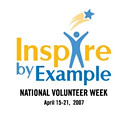This week, April 15-21, is National Volunteer Week, which is about thanking America's most valuable assets — volunteers — and calling the public's attention to all that they do to improve our communities.
Sponsored by the Points of Light Foundation and supported by USA Freedom Corps, this year's theme is "Inspire By Example." Copywrite, Ink. has long encouraged the businesses we work with, and communication-related companies within our field, to find new ways to give back to the community. We try to lead by example.
While we are currently engaged in several non-profit ventures, I would like to highlight just two projects today...
The first is our support of the National Business Community Blog, which is a nationwide community web log and news feed for businesses releasing information about their non-profit contributions and volunteer efforts.
Originally, we developed the blog for the state of Nevada, but recently decided to expand its exposure. As some of the most inspiring stories and charitable ideas from businesses (that could be implemented in Nevada or elsewhere) come from all over the country, it made sense.
Now, every work day, we share one example of a business giving back to its community or communities. Today, you can even learn more about National Volunteer Week.
The second, which will officially launch May 1, is our new agreement with the Volunteer Center of Southern Nevada (Volunteer Center) to provide a merchandise fundraising solution. As a sponsor of the Volunteer Center, we are developing a merchandise product line to help raise funds for its great work in Nevada. A portion of all proceeds from merchandise sales will help support the organization.
We encourage you to visit its Web site. The Volunteer Center helps people deliver creative solutions to community problems through volunteerism.
They will be one of two non-profit organizations that will benefit from our online mall concept. Once both non-profit organizations are added, we will be inviting others to participate as well.
The basic concept is to provide product lines for several companies and non-profit organizations and highlight them all within one online store. Since each organization will assist in driving traffic to the site, all participating companies and organizations will receive greater exposure and a greater fund-raising potential.
We have already amassed a team of more than 20 designers, beyond our in-house team, who are willing to participate in developing products for non-profit organizations. Each of them will receive recognition for their work as their designs are accepted.
In conclusion, I will be posting again on National Volunteer Week this Friday, specifically addressing how business giving has a tangible ROI for businesses, regardless of size and resources. Until then, I ask that everyone take a moment to stop and recognize some volunteers that you know this week. There is no doubt that they make the world a better place.

Sponsored by the Points of Light Foundation and supported by USA Freedom Corps, this year's theme is "Inspire By Example." Copywrite, Ink. has long encouraged the businesses we work with, and communication-related companies within our field, to find new ways to give back to the community. We try to lead by example.
While we are currently engaged in several non-profit ventures, I would like to highlight just two projects today...
The first is our support of the National Business Community Blog, which is a nationwide community web log and news feed for businesses releasing information about their non-profit contributions and volunteer efforts.
Originally, we developed the blog for the state of Nevada, but recently decided to expand its exposure. As some of the most inspiring stories and charitable ideas from businesses (that could be implemented in Nevada or elsewhere) come from all over the country, it made sense.
Now, every work day, we share one example of a business giving back to its community or communities. Today, you can even learn more about National Volunteer Week.
The second, which will officially launch May 1, is our new agreement with the Volunteer Center of Southern Nevada (Volunteer Center) to provide a merchandise fundraising solution. As a sponsor of the Volunteer Center, we are developing a merchandise product line to help raise funds for its great work in Nevada. A portion of all proceeds from merchandise sales will help support the organization.
We encourage you to visit its Web site. The Volunteer Center helps people deliver creative solutions to community problems through volunteerism.
They will be one of two non-profit organizations that will benefit from our online mall concept. Once both non-profit organizations are added, we will be inviting others to participate as well.
The basic concept is to provide product lines for several companies and non-profit organizations and highlight them all within one online store. Since each organization will assist in driving traffic to the site, all participating companies and organizations will receive greater exposure and a greater fund-raising potential.
We have already amassed a team of more than 20 designers, beyond our in-house team, who are willing to participate in developing products for non-profit organizations. Each of them will receive recognition for their work as their designs are accepted.
In conclusion, I will be posting again on National Volunteer Week this Friday, specifically addressing how business giving has a tangible ROI for businesses, regardless of size and resources. Until then, I ask that everyone take a moment to stop and recognize some volunteers that you know this week. There is no doubt that they make the world a better place.


















